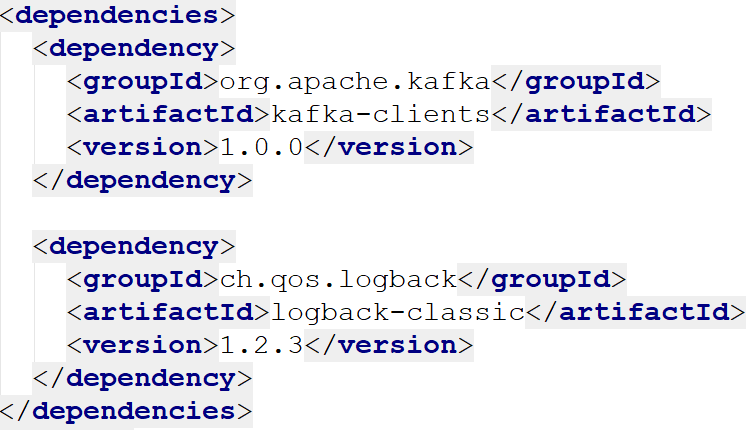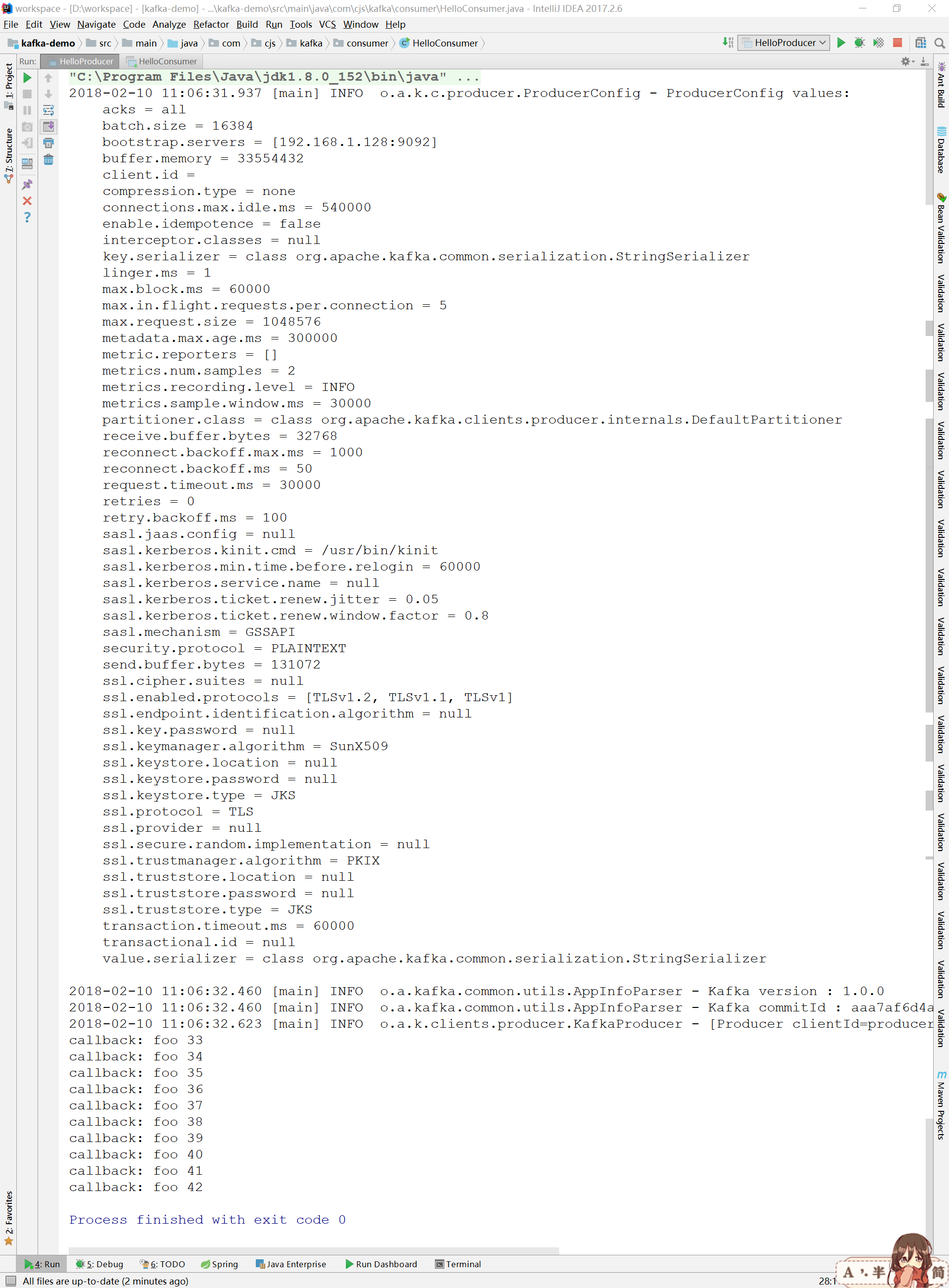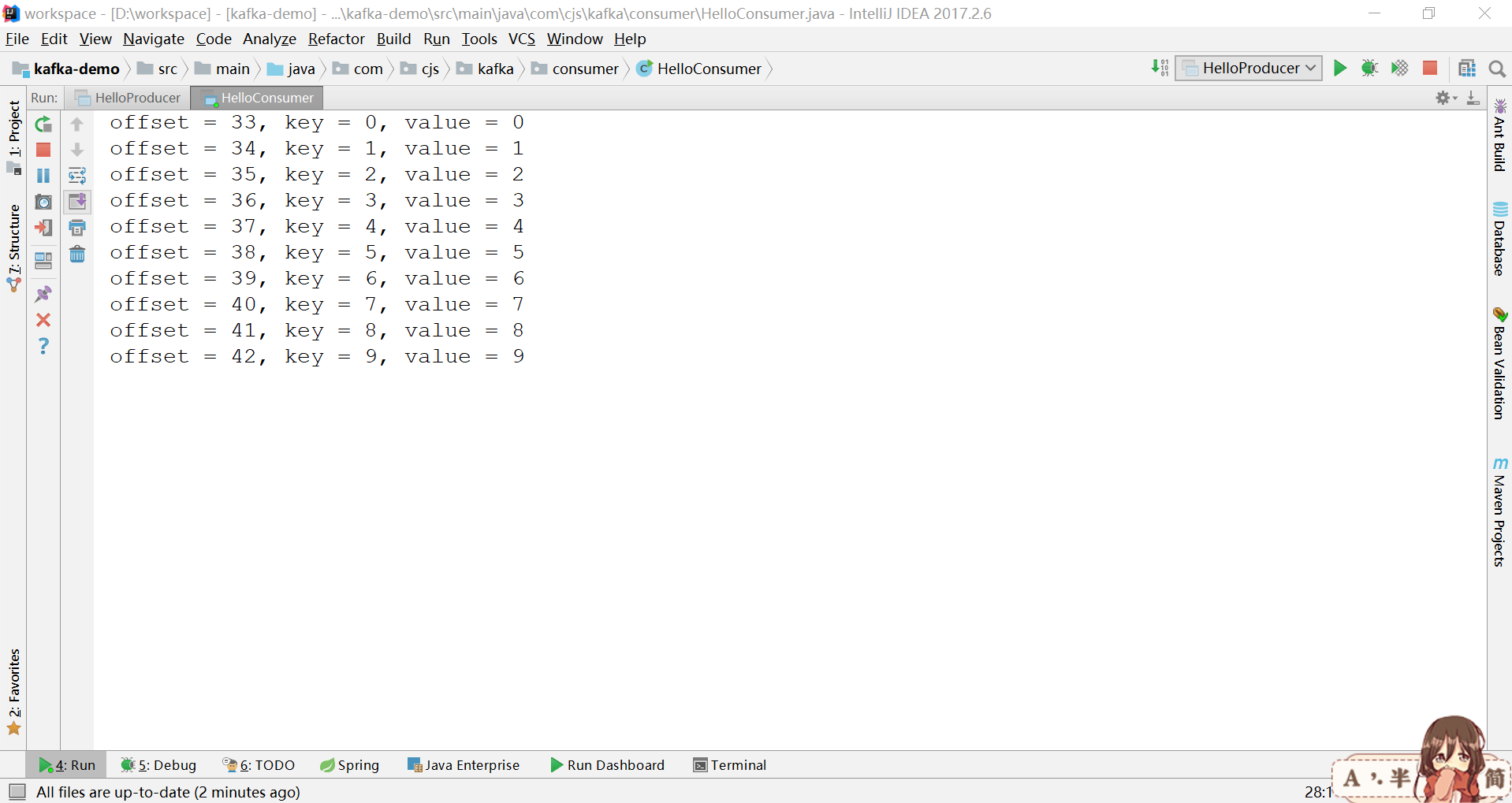Producer API
org.apache.kafka.clients.producer.KafkaProducer
1 props.put("bootstrap.servers", "192.168.1.128:9092"); 2 props.put("acks", "all"); 3 props.put("retries", 0); 4 props.put("batch.size", 16384); 5 props.put("linger.ms", 1); 6 props.put("buffer.memory", 33554432); 7 props.put("key.serializer", "org.apache.kafka.common.serialization.StringSerializer"); 8 props.put("value.serializer", "org.apache.kafka.common.serialization.StringSerializer"); 9 10 Producer<String, String> producer = new KafkaProducer<String, String>(props); 11 for (int i = 0; i < 10; i++) { 12 producer.send(new ProducerRecord<String, String>("foo", Integer.toString(i), Integer.toString(i)), new Callback() { 13 @Override 14 public void onCompletion(RecordMetadata recordMetadata, Exception e) { 15 if (null != e) { 16 e.printStackTrace(); 17 }else { 18 System.out.println("callback: " + recordMetadata.topic() + " " + recordMetadata.offset()); 19 } 20 } 21 }); 22 } 23 producer.close();
producer由一个缓冲池组成,这个缓冲池中维护着那些还没有被传送到服务器上的记录,而且有一个后台的I/O线程负责将这些记录转换为请求并将其传送到集群上去。
send()方法是异步的。当调用它以后就把记录放到buffer中并立即返回。这就允许生产者批量的发送记录。
acks配置项控制的是完成的标准,即什么样的请求被认为是完成了的。本例中其值设置的是"all"表示客户端会等待直到所有记录完全被提交,这是最慢的一种方式也是持久化最好的一种方式。
如果请求失败了,生产者可以自动重试。因为这里我们设置retries为0,所以它不重试。
生产者对每个分区都维护了一个buffers,其中放的是未被发送的记录。这些buffers的大小是通过batch.size配置项来控制的。
默认情况下,即使一个buffer还有未使用的空间(PS:buffer没满)也会立即发送。如果你想要减少请求的次数,你可以设置linger.ms为一个大于0的数。这个指令将告诉生产者在发送请求之前先等待多少毫秒,以希望能有更多的记录到达好填满buffer。在本例中,我们设置的是1毫秒,表示我们的请求将会延迟1毫秒发送,这样做是为了等待更多的记录到达,1毫秒之后即使buffer没有被填满,请求也会发送。(PS:稍微解释一下这段话,producer调用send()方法只是将记录放到buffer中,然后由一个后台线程将buffer中的记录传送到服务器上。这里所说的请求指的是从buffer到服务器。默认情况下记录被放到buffer以后立即被发送到服务器,为了减少请求服务器的次数,可以通过设置linger.ms,这个配置项表示等多少毫秒以后再发送,这样做是希望每次请求可以发送更多的记录,以此减少请求次数)
buffer.memory控制的是总的buffer内存数量
key.serializer 和 value.serializer表示怎样将key和value对象转成字节
从kafka 0.11开始,KafkaProducer支持两种模型:the idempotent producer and the transactional producer(幂等producer和事务producer)。幂等producer强调的是至少一次精确的投递。事务producer允许应用程序原子的发送消息到多个分区或者主题。
为了启用幂等性,必须将enable.idempotence这个配置的值设为true。如果你这样设置了,那么retries默认是Integer.MAX_VALUE,并且acks默认是all。为了利用幂等producer的优势,请避免应用程序级别的重新发送。
为了使用事务producer,你必须配置transactional.id。如果transactional.id被设置,幂等性自动被启用。
1 Properties props = new Properties(); 2 props.put("bootstrap.servers", "192.168.1.128:9092"); 3 props.put("transactional.id", "my-transactional-id"); 4 5 Producer<String, String> producer = new KafkaProducer<String, String>(props, new StringSerializer(), new StringSerializer()); 6 7 producer.initTransactions(); 8 9 try { 10 producer.beginTransaction(); 11 12 for (int i = 11; i < 20; i++) { 13 producer.send(new ProducerRecord<String, String>("bar", Integer.toString(i), Integer.toString(i))); 14 } 15 // This method will flush any unsent records before actually committing the transaction 16 producer.commitTransaction(); 17 } catch (ProducerFencedException | OutOfOrderSequenceException | AuthorizationException e) { 18 producer.close(); 19 } catch (KafkaException e) { 20 // By calling producer.abortTransaction() upon receiving a KafkaException we can ensure 21 // that any successful writes are marked as aborted, hence keeping the transactional guarantees. 22 producer.abortTransaction(); 23 } 24 25 producer.close();
Consumer API
org.apache.kafka.clients.consumer.KafkaConsumer
Offsets and Consumer Position
对于分区中的每条记录,kafka维护一个数值偏移量。这个偏移量是分区中一条记录的唯一标识,同时也是消费者在分区中的位置。例如,一个消费者在分区中的位置是5,表示它已经消费了偏移量从0到4的记录,并且接下来它将消费偏移量为5的记录。相对于消费者用户来说,这里实际上有两个位置的概念。
消费者的position表示下一条将要消费的记录的offset。每次消费者通过调用poll(long)接收消息的时候这个position会自动增加。
committed position表示已经被存储的最后一个偏移量。消费者可以自动的周期性提交offsets,也可以通过调用提交API(e.g. commitSync and commitAsync)手动的提交position。
Consumer Groups and Topic Subscriptions
Kafka用"consumer groups"(消费者组)的概念来允许一组进程分开处理和消费记录。这些处理在同一个机器上进行,也可以在不同的机器上。同一个消费者组中的消费者实例有相同的group.id
组中的每个消费者可以动态设置它们想要订阅的主题列表。Kafka给每个订阅的消费者组都投递一份消息。这归功于消费者组中所有成员之间的均衡分区,以至于每个分区都可以被指定到组中精确的一个消费者。假设一个主题有4个分区,一个组中有2个消费者,那么每个消费者将处理2个分区。
消费者组中的成员是动态维护的:如果一个消费者处理失败了,那么分配给它的分区将会被重新分给组中其它消费者。
在概念上,你可以把一个消费者组想象成一个单个的逻辑订阅者,并且每个逻辑订阅者由多个进程组成。作为一个多订阅系统,Kafka天生就支持对于给定的主题可以有任意数量的消费者组。
Automatic Offset Committing
1 Properties props = new Properties(); 2 props.put("bootstrap.servers", "192.168.1.128:9092"); 3 props.put("group.id", "test"); 4 props.put("enable.auto.commit", "true"); 5 props.put("auto.commit.interval.ms", "1000"); 6 props.put("key.deserializer", "org.apache.kafka.common.serialization.StringDeserializer"); 7 props.put("value.deserializer", "org.apache.kafka.common.serialization.StringDeserializer"); 8 KafkaConsumer<String, String> consumer = new KafkaConsumer<String, String>(props); 9 consumer.subscribe(Arrays.asList("foo", "bar")); 10 while (true) { 11 ConsumerRecords<String, String> records = consumer.poll(100); 12 for (ConsumerRecord<String, String> record : records) { 13 System.out.printf("offset = %d, key = %s, value = %s%n", record.offset(), record.key(), record.value()); 14 } 15 }
设置enable.auto.commit意味着自动提交已消费的记录的offset
Manual Offset Control
代替消费者周期性的提交已消费的offsets,用户可以控制什么时候记录被认为是已经消费并提交它们的offsets。
1 Properties props = new Properties(); 2 props.put("bootstrap.servers", "localhost:9092"); 3 props.put("group.id", "test"); 4 props.put("enable.auto.commit", "false"); 5 props.put("key.deserializer", "org.apache.kafka.common.serialization.StringDeserializer"); 6 props.put("value.deserializer", "org.apache.kafka.common.serialization.StringDeserializer"); 7 KafkaConsumer<String, String> consumer = new KafkaConsumer<>(props); 8 consumer.subscribe(Arrays.asList("foo", "bar")); 9 final int minBatchSize = 200; 10 List<ConsumerRecord<String, String>> buffer = new ArrayList<>(); 11 while (true) { 12 ConsumerRecords<String, String> records = consumer.poll(100); 13 for (ConsumerRecord<String, String> record : records) { 14 buffer.add(record); 15 } 16 if (buffer.size() >= minBatchSize) { 17 insertIntoDb(buffer); 18 consumer.commitSync(); 19 buffer.clear(); 20 } 21 }
代码演示
服务器端

客户端





参考
http://kafka.apache.org/10/javadoc/index.html?org/apache/kafka/clients/producer/KafkaProducer.html
http://kafka.apache.org/10/javadoc/index.html?org/apache/kafka/clients/consumer/KafkaConsumer.html